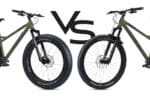Fat biking is a unique and exhilarating way to explore trails, snow, sand, and more. One important decision you’ll make when deciding between fat bikes is choosing a build kit with a rigid fork or suspension fork. Both have their strengths, and the right choice depends on where and how you ride. In this blog post, I break down the key differences and scenarios that will help you decide whether a rigid or suspension fork is best for your fat biking adventures.
Rigid Forks: Lightweight, Simple, and Efficient
A rigid fork is exactly what it sounds like—no moving parts, just a solid piece of material connecting your front wheel to your bike frame. This setup is lightweight, low-maintenance, and ideal for specific types of riding.
Advantages of a Rigid Fork:
- Lightweight and Efficient: Without the added weight and complexity of suspension components, rigid forks are lighter and more energy-efficient, especially on smooth or compact surfaces.
- Simplicity and Durability: With fewer moving parts, a rigid fork is less prone to wear and tear, making it a reliable choice for long-distance adventures or cold-weather rides.
- Direct Feedback: A rigid fork provides direct feedback from the trail, allowing you to feel every contour of the terrain. This is great for riders who value precise handling.
- More Affordable: Rigid forks are generally more affordable than suspension forks making them a suitable option for a lower budget.
Best for:
- Groomed snow trails
- Compacted trails with minimal bumps such as state trails and non-technical single track
- Bikepacking trips where reliability and weight savings are important
Suspension Forks: Comfort and Control
A suspension fork is designed to absorb shocks and bumps, providing a smoother ride and better control on rough terrain. Fat bike suspension forks are typically built to handle low temperatures, wide tires, and varied conditions unique to fat biking.
Advantages of a Suspension Fork:
- Enhanced Comfort: The suspension fork soaks up impacts from rocks, roots, and other obstacles, reducing fatigue and making your ride more enjoyable.
- Improved Traction and Control: By keeping the front wheel in better contact with the ground, the suspension helps you maintain control on technical or uneven trails.
- Versatility: A suspension fork can adapt to a variety of terrains, from rugged backcountry trails to snowy descents.
Best for:
- Rocky, root-filled trails
- Technical terrain with frequent obstacles
- Descents where additional control and stability are essential
PRO TIP: Fat bike suspension forks such as the Wren Inverted and Manitou Mastodon suspension forks are equipped with a lockout toggle. The lockout toggle forces the damper on the fork to lock into place mimicking a rigid fork. This gives you all the advantages of a rigid fork, minus the weight penalty of a few pounds.
How to Decide: Rigid or Suspension Fork for Fat Biking
What terrain will you ride most often?
If your rides are primarily on smooth, groomed trails or hard-packed snow, a rigid fork is likely the better choice. For rocky, bumpy, or technical trails, a suspension fork will enhance your comfort and control.
How important is weight and maintenance?
If you prioritize a lightweight bike and minimal upkeep, the simplicity of a rigid fork is appealing. Suspension forks require occasional maintenance to ensure proper function.
Do you prefer efficiency or comfort?
Riders focused on speed, efficiency, or long-distance rides may prefer a rigid fork, while those prioritizing a smooth and forgiving ride will lean toward suspension.
Blended Options: Suspension-Compatible Rigid Forks
Some fat bikes like the Maverick, are designed to accommodate both rigid and suspension forks making them suspension friendly, allowing you to swap between them depending on the season or terrain. This can be a great option if you ride in varied conditions and want the best of both worlds. Please note that not all fat bikes are suspension friendly and you need to take into consideration what fork length the bike was designed for. The Maverick is designed around a 530mm axle-to-crown length, which works best with a 110mm Wren Inverted Suspension fork or either a 100mm or 120mm Manitou Mastodon Gen 3 suspension fork.
Please note. The only rigid fork that works with the Maverick is the Wren Carbon Rigid fork as it has an axle-to-crown length of 505mm, which is similar to the length of the previously mentioned forks with a 20% sag. It is not recommended to use a rigid fork on the Maverick that has an axle-to-crown length of less than 505mm. Currently, the only rigid fat fork that is compatible is the Wren Carbon Rigid fork.
Conclusion: Match Your Fork to Your Riding Style
Choosing between a rigid and suspension fork ultimately comes down to your riding style, terrain, and personal preferences. Rigid forks are ideal for simplicity and efficiency on smooth trails, while suspension forks offer the comfort and control needed for tackling rugged terrain.
Still not sure? Please contact us and we would be happy to recommend the best fork option for your style of riding.



